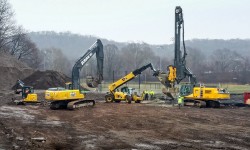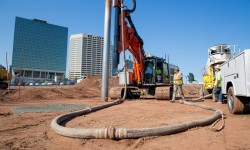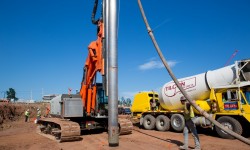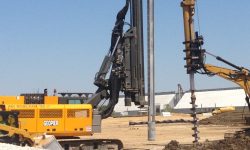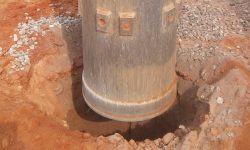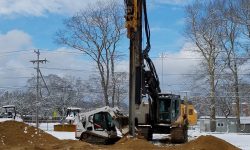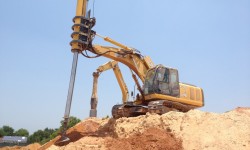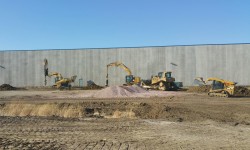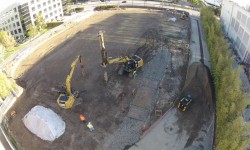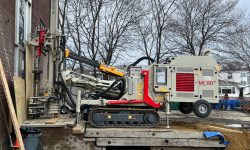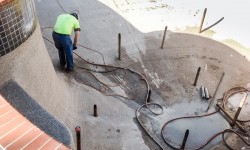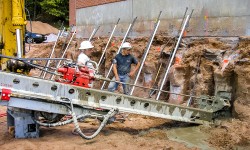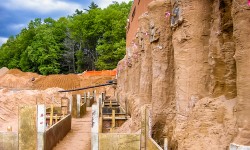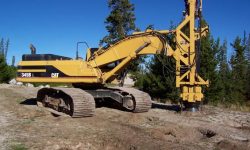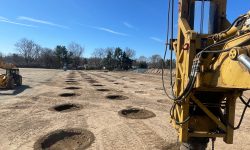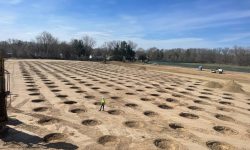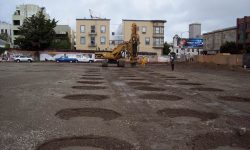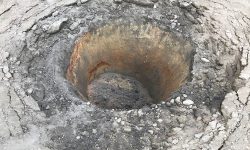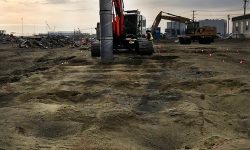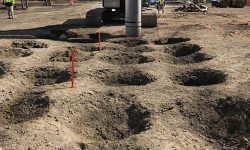Ground Improvement
Geopier® Ground Improvement Techniques
- Geopier Impact® Rammed Aggregate Pier® Elements
- Geopier GeoConcrete® Column Rigid Inclusions
- Geopier X1® Rammed Aggregate Pier Elements
- Geopier GP3® Rammed Aggregate Pier® Elements
Specialty Ground Improvement Techniques
GEOPIER® GROUND IMPROVEMENT
Why Geopier Ground Improvement? Geopier® systems consist of engineered design/build methods of soil reinforcement that enhance unsuitable soils to provide an improved subgrade for traditional shallow footing and slab-on-grade support. They provide a cost-effective solution to support heavy applied loads and control settlement on sites with weak, compressible, or otherwise unsuitable soils. Geopier systems are an effective alternative to excavation/replacement of unsuitable soils or deep foundations such as driven piles, pressure injected footings (PIFs), drilled piles/shafts or augercast piles. Over two decades ago, the Geopier Foundation Company® developed their first ground improvement system, the Rammed Aggregate Pier system (RAPs), as an efficient and cost effective foundation support alternative. Helical Drilling introduced Geopier RAP ground improvement to the Northeastern United States over a decade ago and now designs/installs the following types of Geopier systems:
Geopier Impact® Rammed Aggregate Pier® Elements
A DISPLACEMENT TECHNIQUE
Geopier Impact RAPs are ground improvement elements that reinforce unsuitable soils to provide an improved subgrade for traditional shallow footing and slab-on-grade support. Impact RAPs consist of stiff columns of rammed aggregate that are constructed with a patented displacement mandrel equipped with a beveled tamping foot. The mandrel and tamping foot apply direct vertical ramming energy to densely compact successive lifts of high quality crushed rock. The vertical ramming action also increases the lateral stress and improves the surrounding soils, resulting in high-stiffness engineered elements. The displacement mandrel generates little to no excess spoils and eliminates the need for casing or dewatering. This displacement construction method is particularly advantageous on sites with caving soils, contaminated soils, and/or shallow groundwater. Impact RAPs can also be grouted to provide enhanced stiffness through relatively soft soil layers (such as organics or soft clay). For these reasons, Impact RAPs are the most-used widely used Geopier ground improvement system in the Northeastern United States. LEARN MORE
View Our Case Studies & Related Projects >
Geopier GeoConcrete® Column Rigid Inclusions
A DISPLACEMENT TECHNIQUE
Geopier GeoConcrete Columns (GCCs) are rigid inclusion ground improvement elements that enhance unsuitable soil conditions to provide an improved subgrade for traditional shallow footing support. GCC rigid inclusions consist of stiff columns of unreinforced concrete that are constructed with a patented displacement mandrel equipped with a beveled tamping foot. The displacement mandrel generates little to no excess spoils and eliminates the need for casing or dewatering. This displacement construction method is particularly advantageous on sites with caving soils, contaminated soils, and/or shallow groundwater. GCCs are an especially effective solution on sites with relatively thick weak and compressible soils (such as organics or soft clay) combined with heavy structural loads. LEARN MORE
View Our Case Studies & Related Projects >
View the Holiday Inn Chelsea installation footage where GCCs were installed to depths of 60 feet
Geopier X1® Rammed Aggregate Pier Elements
A PRE-AUGERED “DRILL AND FILL” OR DISPLACEMENT TECHNIQUE
Geopier X1 RAPs are ground improvement elements that reinforce unsuitable soils to provide improved bearing capacity and settlement control for conventional shallow footing and slab-on-grade support. X1 RAPs consist of stiff columns of rammed aggregate and are the newest type of Geopier RAP in our ground improvement “arsenal”. They are constructed with a patented mandrel and compaction chamber that allows us to install RAPs faster and more efficiently than ever before. X1 RAPs can be installed using a pre-augered “drill-and-fill” replacement construction method OR a fully displacement method that does not require pre-augering. The selected construction method is a function of the site-specific subsurface conditions. For sites with non-caving soils such as silty or clayey soils, the drill-and-fill (replacement) construction method is more appropriate and consists of predrilling an augered cavity and filling it with successive compacted lifts of imported aggregate. For sites with caving soils such as clean sand or gravel soils, the displacement method is more appropriate and allows the existing site soils to cave into the mandrel and “self-serve” as the RAP aggregate (how efficient!). Imported aggregate can be added to the displacement method to supplement the site soils as needed. Both X1 construction methods compact the lifts of aggregate with direct vertical ramming energy that results in high-stiffness engineered elements. The vertical ramming action also increases the lateral stress and improves the surrounding soils. The end result is an improved subgrade that is ready to receive traditional shallow footings designed for higher bearing pressures and a slab-on-grade.
View Our Case Studies & Related Projects >
Geopier GP3® Rammed Aggregate Pier® Elements
A PREDRILLED “DRILL AND FILL” TECHNIQUE
Geopier GP3 RAPs are ground improvement elements that reinforce unsuitable soils to provide an improved subgrade for traditional shallow footing and slab-on-grade support. GP3 RAPs consist of stiff columns of rammed aggregate and were the first type of Geopier elements to be installed in the Northeast. They are constructed using a “drill and fill” method, which consists of predrilling an augered cavity and filling it with successive lifts of high quality crushed rock. Each lift of aggregate is compacted with a patented beveled tamper that applies direct vertical ramming energy, resulting in high-stiffness engineered elements. The vertical ramming action also increases the lateral stress and improves the surrounding soils. Since GP3 RAPs are constructed with a predrilled “open-hole”, they are an effective solution for soils that are not subject to caving, such as clay. For soils that are subject to caving, Geopier Impact Rammed Aggregate Piers or Geopier GeoConcrete Columns may be more appropriate.
SPECIALTY GROUND IMPROVEMENT TECHNIQUES
Compaction Grouting (Compaction Grout Columns)
Compaction grouting, also known as low mobility grouting, is a ground improvement technique that reinforces unsuitable soils in-place and is used to remediate sinking structures or to underpin existing foundations. Compaction grouting can be performed with only 6 feet of overhead space. The process of compaction grouting involves advancing small-diameter temporary steel casing to a predetermined design depth and then pumping a stiff (low mobility, low slump) grout in controlled lifts at high pressure as the casing is gradually withdrawn. This process displaces and compacts the surrounding soil and builds high-stiffness compaction grout columns. The stiff columns, combined with the improved surrounding soils, act together to support the structure. The grouting material is mixed on-site with a mobile mixer and is injected in a controlled manner to predetermined volume, pressure or movement criteria. In some instances, compaction grout columns can be used to jack up existing structures that have undergone settlement.
View Our Case Studies & Related Projects >
Jet Grouting
Jet grouting is a ground improvement technique that improves unsuitable soils in-place and is used for underpinning existing foundations, constructing earth support walls, and constructing groundwater cutoff walls. The process of jet grouting involves advancing steel drill rods using a high-pressure bottom discharge water/grout jet, stopping the bottom-discharge once the predetermined design depth is reached, and then engaging a high pressure side-discharge grout jet that erodes and mixes the soil as the drill rod string is slowly rotated and gradually withdrawn. This process creates “soilcrete” jet grout columns with increased strength and reduced permeability.
View Our Case Studies & Related Projects >
Rapid Impact Compaction (RIC)
Rapid Impact Compaction (RIC) is a ground improvement method that densifies existing surficial granular soil layers up to about 10 to 15-feet-thick. RIC enhances unsuitable soils in-place, resulting in an improved subgrade capable of supporting traditional shallow footings, slabs-on-grade, pavements, or other features that require a stable soil subgrade. RIC can be a cost-effective alternative to removal and replacement of unsuitable soils and other forms of ground improvement, such as deep dynamic compaction (DDC).
RIC is performed with a self-contained hydraulic hammer assembly equipped with a 5-foot diameter tamping foot. The hammer assembly and tamping foot are mounted on the front of a large tracked excavator.
RIC is typically performed in a tightly spaced grid pattern throughout (and just beyond) the proposed building footprint area. At each RIC grid point, the tamping foot delivers high-energy compactive “Drops” in rapid succession at a rate of about 40 to 50 Drops per minute. One “Pass” at a RIC grid point consists of a prescribed number of Drops (usually about 10 to 50 Drops). A Pass is considered complete after the prescribed number of Drops has been completed, or practical refusal has been achieved. After one Pass has been performed through the site at each RIC grid point, the resulting “craters” are backfilled and leveled. Secondary and tertiary Passes are sometimes completed depending on the results of the first Pass and the requirements of the project geotechnical consultant.
View Our Case Studies & Related Projects >
Vibratory Probe Compaction (VPC)
Vibratory Probe Compaction (VPC) is a deep ground improvement method that densifies loose, clean granular soils in-place (above or below the groundwater table). VPC is sometimes an economical alternative to other ground improvement methods or removal/replacement. VPC is a dry process that does not require (messy) water jetting, earth berms, or other premium site costs.
VPC consists of repeatedly driving and extracting an open-ended, large-diameter steel pipe into the ground using a large, high-frequency vibratory hammer. The probe has plate straps (ribs) welded to the outside surface to help transfer vertical vibrations to the granular soil to be densified. The vibrations and lateral displacement cause the soil particles to rearrange into a denser configuration. VPC is carried out in a grid pattern across the site; each probe location receives multiple cycles of treatment depending on the desired results and the site response during driving. Soil density is increased uniformly across the site, resulting in improved settlement control and enhanced bearing capacity. The effectiveness of VPC treatment is typically evaluated by comparing pre-treatment and post-treatment SPT N-values.
Following VPC treatment, the site contractor strips the treated area to the bottom of any surface craters that develop during probing and then performs heavy surface compaction (with vibratory rollers) to prepare the site for foundation work.
View Our Case Studies & Related Projects >



